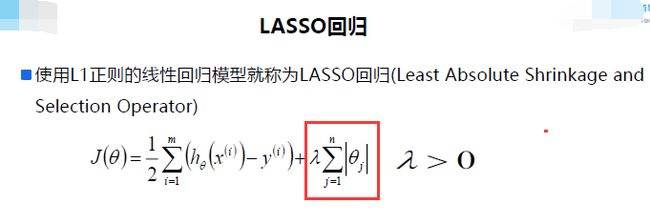在函数中加入一个正则项:
三种方式:
一、Ridge回归(岭回归):
优点:具有较高的准确性、鲁棒性以及稳定性
缺点:求解速度慢
二、Lasso回归:
优点:求解速度快(原理降维计算,把数据维度中存在的噪音和冗余去除)
缺点:相比Ridge回归没有较高的准确性、鲁棒性以及稳定性
三、弹性网络:
特点:综合了以上两种回归算法的特性。计算效率以及鲁棒性兼备。
几种回归解决拟合问题的综合比较:
GIthub:代码
https://github.com/chenjunhaolefa/AI/blob/master/MachineLearning/LinearRegression03.py
# coding=utf-8
'''
下面的代码是用一个小例子解决线性回归过拟合问题
'''
import numpy as np
import matplotlib as mpl
import matplotlib.pyplot as plt
import pandas as pd
import warnings
import sklearn
from sklearn.linear_model import LinearRegression, LassoCV, RidgeCV, ElasticNetCV
from sklearn.preprocessing import PolynomialFeatures
from sklearn.pipeline import Pipeline
from sklearn.linear_model.coordinate_descent import ConvergenceWarning
#解决画图产生的中文乱码问题
mpl.rcParams['font.sans-serif']=[u'simHei']
mpl.rcParams['axes.unicode_minus']=False
#生成一段数据来测试一下拟合问题
np.random.seed(100)
np.set_printoptions(linewidth=1000, suppress=True)
N = 10
x = np.linspace(0, 6, N) + np.random.randn(N)
y = 1.8*x**3 + x**2 - 14*x - 7 + np.random.randn(N)
x.shape = -1, 1
y.shape = -1, 1
#模型
models = [
Pipeline([
('Poly', PolynomialFeatures()),
('Linear', LinearRegression(fit_intercept=False))
]),
Pipeline([
('Poly', PolynomialFeatures()),
('Linear', RidgeCV(alphas=np.logspace(-3,2,50), fit_intercept=False))
]),
Pipeline([
('Poly', PolynomialFeatures()),
('Linear', LassoCV(alphas=np.logspace(-3,2,50), fit_intercept=False))
]),
Pipeline([
('Poly', PolynomialFeatures()),
('Linear', ElasticNetCV(alphas=np.logspace(-3,2,50), l1_ratio=[.1, .5, .7, .9, .95, 1], fit_intercept=False))
])
]
plt.figure(facecolor='W')
degree = np.arange (1, N, 2) # 定义函数的阶数 X^2代表2阶函数 N表示N阶
dm = degree.size
colors = [] # 颜色
for c in np.linspace (16711680, 255, dm):
colors.append ('#%06x' % c)
titles = [u'线性回归', u'Ridge回归', u'Lasso回归', u'ElasticNet']
for t in range(4):
model = models[t]
plt.subplot(2, 2, t + 1)
plt.plot(x, y, 'ro', ms=5, zorder=N)
for i, d in enumerate(degree):
model.set_params(Poly__degree=d)
model.fit(x, y.ravel())
lin = model.get_params('Linear')['Linear']
output = u'%s:%d阶,系数为:' % (titles[t], d)
print output, lin.coef_.ravel()
x_hat = np.linspace(x.min(), x.max(), num=100)
x_hat.shape = -1, 1
y_hat = model.predict(x_hat)
s = model.score(x, y)
z = N - 1 if (d == 2) else 0
label = u'%d阶, 正确率=%.3f' % (d, s)
plt.plot(x_hat, y_hat, color=colors[i], lw=2, alpha=0.75, label=label, zorder=z)
plt.legend(loc='upper left')
plt.grid(True)
plt.title(titles[t])
plt.xlabel('X', fontsize=16)
plt.ylabel('Y', fontsize=16)
plt.tight_layout(1, rect=(0, 0, 1, 0.95))
plt.suptitle(u'各种不同线性回归过拟合显示', fontsize=22)
plt.show()



